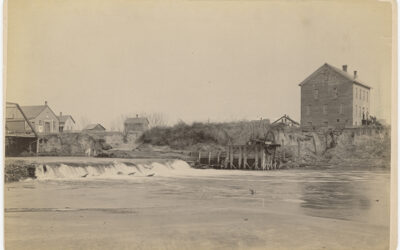 A riot-crazed mob stormed the burning Douglas County Courthouse on September 28, 1919, and lynched an African American, Will Brown. The victim, accused of raping a white woman, had no opportunity to prove his innocence. Political boss Tom Dennison and his allies may have encouraged the lynching in order to discredit Mayor Edward P Smith, an advocate for reform.
A riot-crazed mob stormed the burning Douglas County Courthouse on September 28, 1919, and lynched an African American, Will Brown. The victim, accused of raping a white woman, had no opportunity to prove his innocence. Political boss Tom Dennison and his allies may have encouraged the lynching in order to discredit Mayor Edward P Smith, an advocate for reform.
Around midnight on September 25, 1919, Milton Hoffman and Agnes Loeback were assaulted at Bancroft Street and Scenic Avenue as they were walking home after a late movie. They said their assailant robbed them at gunpoint, taking Hoffman’s watch, money, and billfold, plus a ruby ring from Agnes. He ordered Hoffman to move several steps away, then dragged nineteen-year-old Loeback by her hair into a nearby ravine and raped her.
On Friday the twenty-sixth, an Omaha Bee headline proclaimed that a “black beast” had assaulted a white girl. Police and detectives combed the vicinity for two hours, joined by four hundred armed men under the leadership of Joseph Loeback (Agnes’s brother) and Frank B. Raum. The group included railroad workers who knew Agnes from her job at an eatery (she also worked in a laundry). A neighbor told the searchers of a “suspicious negro” living in a house at 2418 South Fifth Street with a white woman, Virginia Jones, and a second black man, Henry Johnson. Raum and four of his men found William Brown at the house and covered him with a shotgun. Arriving on the scene, police found Brown hiding under his bed. They took him to Loeback’s home nearby, bringing with them clothes found in Brown’s room. Loeback and Hoffman identified Brown as their assailant.
Widespread violence erupted in some twenty-five U.S. cities during the “Red Summer” of 1919. Adding to Omaha’s disquiet and distrust was a political battle between a recently elected city reform movement and an entrenched political machine eager to regain control by demonstrating the ineptness of the reformer “goo-goos.”
In its alliance with Tom “the Old Man” Dennison, Omaha’s powerful political boss, the Omaha Bee was the primary strident voice of alleged racially shocking crimes. Alarmed at the Bee’s promotion of violence and racial prejudice, the Rev. John A. Williams—first president of the local chapter of the NAACP and publisher of the Monitor, a weekly black paper—called upon the editors of the Bee and the Daily News to stop their propaganda. The Bee was charged with being the mouthpiece of a gang that ruled Omaha with the cooperation of behind-the-scene influential who decided who should run for office, with Dennison’s organization electing them. In return, according to the source, Dennison received money and control of the police department, juries, and the police court to protect the cities vice interests.
A potent and combustible component of the racial divide was sex—the longstanding notion of black men preying on white women. A day before Brown’s lynching, U.S. Senator John Sharp Williams proclaimed that “the protection of a woman transcends all law of every description, human or divine,” legitimizing the mostly sex-related lynching’s of African Americans. Fifty-four blacks were lynched in the United States in 1916; by 1920 the annual number had grown to eighty-three.
Given the fuel provided by Tom Dennison and his allies, Brown may have been the victim of a politically inspired maneuver to restore the city officials dislodged by the 1918 election. Brown’s death was timely, if not timed, to provide an opportunity to strike hard at Mayor Ed Smith. Dennison’s machine won the next election.
This is an excerpt from “Lest We Forget: The Lynching of Will Brown, Omaha’s 1919 Race Riot” by Orville D Menard, which appeared in the Fall/Winter 2010 issue of Nebraska History. Read the full article for more information.
You may also be interested in:
“Did Claude Nethaway murder his wife and frame an innocent man?” — Nethaway was accused of taking a prominent role in Brown’s lynching. It was hardly the only time he was in the news for something heinous.
Laurel Sariscsany, “‘They can’t convict anyone anyway’: The trials of the Omaha lynching and riot of 1919.” This article appears exclusively in the Fall 2019 issue of Nebraska History Magazine, received by History Nebraska members.




